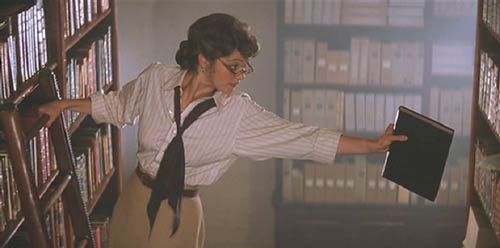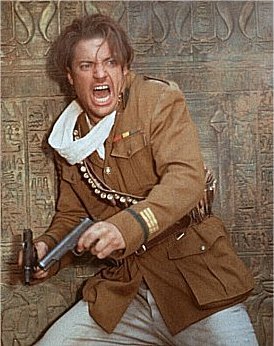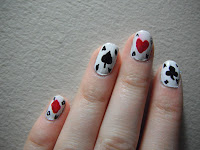



Edited to make it a little easier to read. Click on the images to make them bigger.
This blog is no longer active. Please visit http://www.knotmagickknitter.wordpress.com for my newest posts!


 Her '62 Cadillac convertible is more than drool-worthy in my opinion. Put a bow on it, I'll take it!
Her '62 Cadillac convertible is more than drool-worthy in my opinion. Put a bow on it, I'll take it! I love the nipped in waist lines and the full, swishy skirts. I also love that the center dress was "handmade" (at least, according to the story line) even if I don't like the woman who "made" it so much.
I love the nipped in waist lines and the full, swishy skirts. I also love that the center dress was "handmade" (at least, according to the story line) even if I don't like the woman who "made" it so much. I guess I'm not the only one who loves the costumes from this movie, since there was a display around the time of the premier. I love the apricot dress on the right, which Skeeter wears to dinner. I hate the romper on principal. Rompers should remain in the past where they belong, but every time we get a truck in at work I get proof that they refuse to die.
I guess I'm not the only one who loves the costumes from this movie, since there was a display around the time of the premier. I love the apricot dress on the right, which Skeeter wears to dinner. I hate the romper on principal. Rompers should remain in the past where they belong, but every time we get a truck in at work I get proof that they refuse to die. This is possibly one of my favorite outfits. It's simple, business like, and very flattering (fun fact: there's one almost identical to it in the Nancy Drew movie, and Skeeter wears a similar outfit in green later in the movie. Must have been a popular style). I also adore the leather satchel that Skeeter carries all of her business papers in.
This is possibly one of my favorite outfits. It's simple, business like, and very flattering (fun fact: there's one almost identical to it in the Nancy Drew movie, and Skeeter wears a similar outfit in green later in the movie. Must have been a popular style). I also adore the leather satchel that Skeeter carries all of her business papers in.








 Part of the reason I like this look is that while it is a period piece, and while it does involve British influences and have all the manners and niceties of the early 20th century, he's not wearing a suit. It's a nice departure.
Part of the reason I like this look is that while it is a period piece, and while it does involve British influences and have all the manners and niceties of the early 20th century, he's not wearing a suit. It's a nice departure.



 Kate became a stewardess to gain independence from her controlling, overprotective mother. Laura did much the same...after running away from her own wedding. Really, what girl wouldn't need to get out of the country after something like that?
Kate became a stewardess to gain independence from her controlling, overprotective mother. Laura did much the same...after running away from her own wedding. Really, what girl wouldn't need to get out of the country after something like that?3. an employee who has charge of the table, wine, servants, etc., in a club, restaurant, or the like.4. a person who attends to the domestic concerns of persons on board a vessel, as in overseeing maids and waiters.5. an employee on a ship, train, or bus who waits on and is responsible for the comfort of passengers, takes orders for or distributes food, etc."
 Seeing as they required the use of a girdle, I doubt the trademark blue suits were comfortable, or that it was practical to spend so many hours in heels, but it certainly does make a lovely picture.
Seeing as they required the use of a girdle, I doubt the trademark blue suits were comfortable, or that it was practical to spend so many hours in heels, but it certainly does make a lovely picture.
 [another example, which blogger doesn't seem to want to load]
[another example, which blogger doesn't seem to want to load]


 Once again, I love the way Rizzo is dressed--she's the only female character to regularly eschew skirts and dresses, even at school, and I love her favored highwaters and the pencil skirt she wears on the first day of classes (left).
Once again, I love the way Rizzo is dressed--she's the only female character to regularly eschew skirts and dresses, even at school, and I love her favored highwaters and the pencil skirt she wears on the first day of classes (left). And don't even get me start on the dance off scene; oh my gosh, I love the dresses. In particular, Marty and Rizzo's picks. They are form-fitted without being revealing, and the colors are bright, eye catching, and just right for both the actresses and the characters.
And don't even get me start on the dance off scene; oh my gosh, I love the dresses. In particular, Marty and Rizzo's picks. They are form-fitted without being revealing, and the colors are bright, eye catching, and just right for both the actresses and the characters.

 I love the costumes in this series, especially the ones they choose for Dr. Ogden. She always looks extremely elegant, but always approachable. Another thing that I like--you frequently see her in the same costume or reusing costume pieces. Yes, I know it is a mark of budget constrictions, but it always bothers me in a tv series when every time a character pops up, they're wearing something different. I frequently find myself wondering, "Exactly how many coats does she have? Where does she keep all of those dresses?" I feel that by giving her a staple wardrobe for day-to-day use, it makes her character more realistic. [Historical Note: Dr. Ogden is based on the real-life Dr. Julia Byrne, who worked in Toronto around the same time period.]
I love the costumes in this series, especially the ones they choose for Dr. Ogden. She always looks extremely elegant, but always approachable. Another thing that I like--you frequently see her in the same costume or reusing costume pieces. Yes, I know it is a mark of budget constrictions, but it always bothers me in a tv series when every time a character pops up, they're wearing something different. I frequently find myself wondering, "Exactly how many coats does she have? Where does she keep all of those dresses?" I feel that by giving her a staple wardrobe for day-to-day use, it makes her character more realistic. [Historical Note: Dr. Ogden is based on the real-life Dr. Julia Byrne, who worked in Toronto around the same time period.] No, not my contest. Though I am donating one of the prizes.
No, not my contest. Though I am donating one of the prizes. Man's Ghost, on her blog. Also included in the prize pack is a set of knitting needles and some handspun yarn (made by yours truly).
Man's Ghost, on her blog. Also included in the prize pack is a set of knitting needles and some handspun yarn (made by yours truly). This is the Malibrigo Lace I picked up last week at The Yarn Shop in Clintonville (I would link to their site, but it seems to be down for a revamp). I don't go up that way too often, since I have a difference of opinion with both the owner and most of the regulars, but the last time Missouri and I went in, there were several new people sitting around the work table and they were all very lovely to talk to--enough that I'd love to make another trip in the near future.
This is the Malibrigo Lace I picked up last week at The Yarn Shop in Clintonville (I would link to their site, but it seems to be down for a revamp). I don't go up that way too often, since I have a difference of opinion with both the owner and most of the regulars, but the last time Missouri and I went in, there were several new people sitting around the work table and they were all very lovely to talk to--enough that I'd love to make another trip in the near future. My second yarny purchase in the last couple of weeks was some spinning fiber from Fiber Optic Yarns. I wanted something brightly colored and easy to spin to take with me to Steampunk Symposium, and decided that as much as I prefer to use fibers like silk, I wanted something a bit grippier and easier to work with while at the busy convention, so I settled on some superwash merino. I usually don't spin or knit with wool unless it's in a blend that is at least 50% something else, but I can use superwash. I suspect that whatever chemical treatment makes it superwash (i.e. removes or "glues" down the follicles on the individual fibers so that it can't felt) also removes the lanolin or whatever it is that gives me problems with it. I might not be able to rub my belly and pat my head at the same time, but it is a very good thing to be able to spin and breathe at the same time.
My second yarny purchase in the last couple of weeks was some spinning fiber from Fiber Optic Yarns. I wanted something brightly colored and easy to spin to take with me to Steampunk Symposium, and decided that as much as I prefer to use fibers like silk, I wanted something a bit grippier and easier to work with while at the busy convention, so I settled on some superwash merino. I usually don't spin or knit with wool unless it's in a blend that is at least 50% something else, but I can use superwash. I suspect that whatever chemical treatment makes it superwash (i.e. removes or "glues" down the follicles on the individual fibers so that it can't felt) also removes the lanolin or whatever it is that gives me problems with it. I might not be able to rub my belly and pat my head at the same time, but it is a very good thing to be able to spin and breathe at the same time. I've got the ribbon color selector, caps lock, and (on my right hand, which did not photograph as well) the tab and semi-colon keys. In retrospect, I realized it would have been cool to use Magic Margin instead of the caps or tab keys, but maybe for next time. This is more of a dry run, anyway. I'm not crazy about the base color, and I need a larger color pallet before I can attempt the glass keys I originally wanted to do. I also had to redo the lettering. The first time, I asked Missouri to do it but it rubbed off before I could apply the clear coat. Once I get the chrome/metalic I need, I'll try again in more detail.
I've got the ribbon color selector, caps lock, and (on my right hand, which did not photograph as well) the tab and semi-colon keys. In retrospect, I realized it would have been cool to use Magic Margin instead of the caps or tab keys, but maybe for next time. This is more of a dry run, anyway. I'm not crazy about the base color, and I need a larger color pallet before I can attempt the glass keys I originally wanted to do. I also had to redo the lettering. The first time, I asked Missouri to do it but it rubbed off before I could apply the clear coat. Once I get the chrome/metalic I need, I'll try again in more detail.
 The Mario nails seem to have gotten me hooked. I've been giving myself decorative manicures every couple of days. Currently, it's a deck of cards inspired by watching Missouri play Alice: The Madness Returns. I did these a couple of days ago, so they're not as fresh and clean as they could be (my sock needles rubbed off part of the thumb). I also discovered that my clear coat seems to cause the other colors to bleed. It's not as noticeable on a darker base color, but you can really tell on the white. I do have a typewriter themed manicure planned in the future, but I'm sure I can do lettering with my left hand. I might try a stencil of some kind. Maybe contact paper would work.
The Mario nails seem to have gotten me hooked. I've been giving myself decorative manicures every couple of days. Currently, it's a deck of cards inspired by watching Missouri play Alice: The Madness Returns. I did these a couple of days ago, so they're not as fresh and clean as they could be (my sock needles rubbed off part of the thumb). I also discovered that my clear coat seems to cause the other colors to bleed. It's not as noticeable on a darker base color, but you can really tell on the white. I do have a typewriter themed manicure planned in the future, but I'm sure I can do lettering with my left hand. I might try a stencil of some kind. Maybe contact paper would work.





